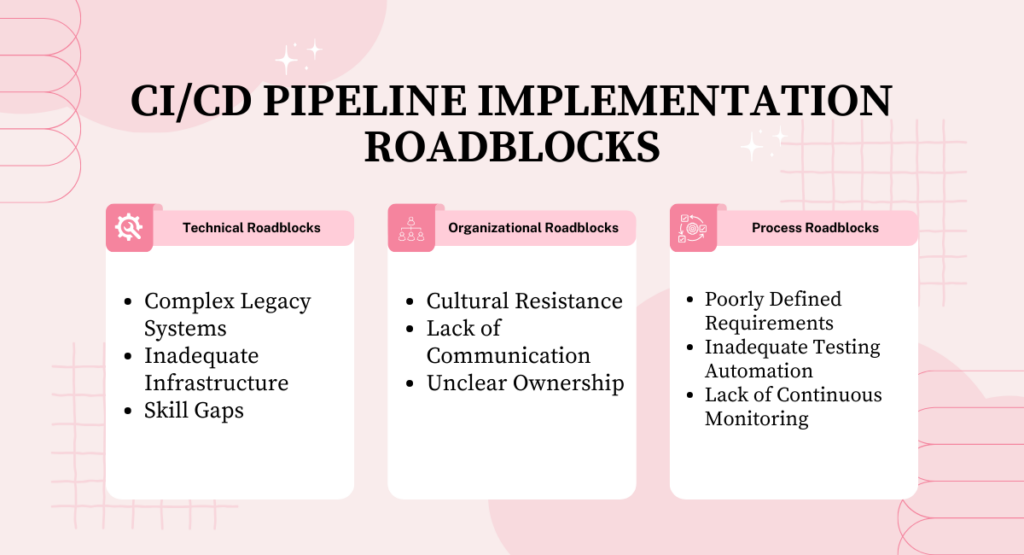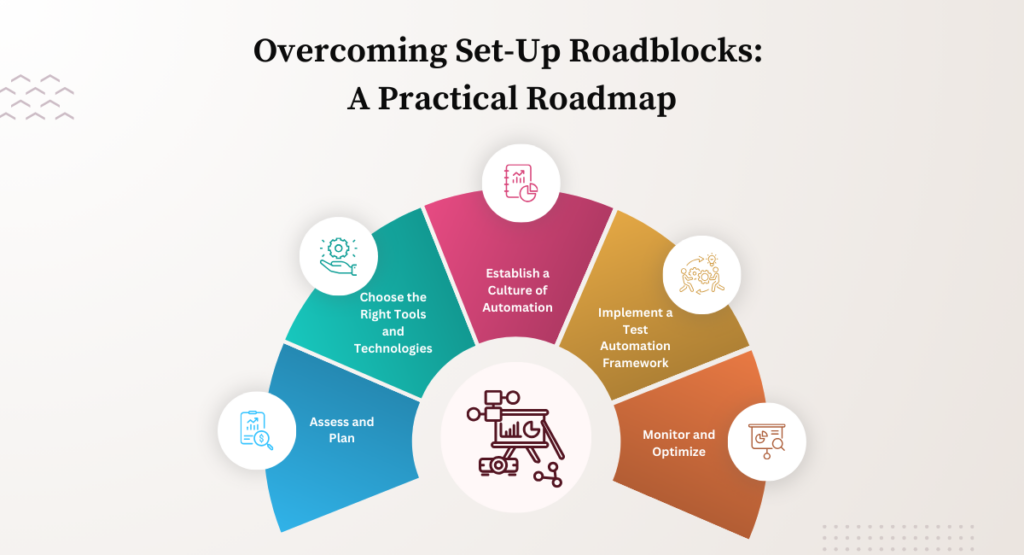Continuous Integration and Continuous Delivery pipelines (CI/CD) pipeline implementation have become essential tools for delivering high-quality software quickly and reliably.
However, CI/CD pipeline implementation can be a complex and challenging task, often plagued by set-up roadblocks that can hinder progress and frustrate developers.
This blog post will provide a practical roadmap for overcoming these roadblocks and successfully CI/CD pipeline implementation in your organization.
CI/CD pipeline implementation Roadblocks
Before diving into the CI/CD pipeline implementation process, it's crucial to identify the common roadblocks that organizations often encounter.
These roadblocks can be categorized into three main areas:

Technical Roadblocks:
- Complex Legacy Systems: Integrating CI/CD pipelines into legacy systems can be challenging due to their outdated architecture and lack of automation.
- Inadequate Infrastructure: Insufficient infrastructure resources, such as compute power and storage, can hinder the performance and scalability of the CI/CD pipeline.
- Skill Gaps: A lack of expertise in CI/CD tools and techniques among developers can lead to inefficient implementations and troubleshooting difficulties.
Organizational Roadblocks:
- Cultural Resistance: Resistance to change from traditional development processes can hinder the adoption of CI/CD practices.
- Lack of Communication: Poor communication between development, testing, and operations teams can lead to misunderstandings and workflow disruptions.
- Unclear Ownership: Unclear ownership of the CI/CD pipeline can lead to a lack of accountability and responsibility for its maintenance and improvement.
Process Roadblocks:
- Poorly Defined Requirements: Ambiguous requirements for the CI/CD pipeline can lead to scope creep and implementation delays.
- Inadequate Testing Automation: Insufficient test automation coverage can reduce the effectiveness of the CI/CD pipeline in detecting and preventing defects.
- Lack of Continuous Monitoring: Failing to monitor the health and performance of the CI/CD pipeline can lead to undetected issues and potential breakdowns.
Overcoming Set-Up Roadblocks: A Practical Roadmap

To successfully implement a CI/CD pipeline, organizations must develop a comprehensive strategy that addresses the technical, organizational, and process roadblocks mentioned above.
Here's a practical roadmap to guide you through the implementation process:
1. Assess and Plan:
- Conduct a thorough assessment of your current development and deployment processes.
- Identify the specific needs and goals for CI/CD pipeline implementation
- Define clear requirements and success criteria for the CI/CD pipeline.
- Create a detailed implementation plan that outlines the steps, resources, and timelines.
2. Choose the Right Tools and Technologies:
- Evaluate and select CI/CD tools that align with your organization's size, technical expertise, and budget.
- Consider cloud-based CI/CD solutions for scalability and flexibility.
- Ensure compatibility between CI/CD tools and your existing development and deployment environment.
3. Establish a Culture of Automation:
- Foster a culture of automation within the development team.
- Provide training and support to developers on CI/CD practices and tools.
- Encourage continuous improvement and experimentation with CI/CD processes.
4. Implement a Test Automation Framework:
- Develop a comprehensive test automation framework that covers unit, integration, and end-to-end testing.
- Utilize automated testing tools to streamline the testing process and ensure quality.
- Continuously integrate automated testing into the CI/CD pipeline.
5. Monitor and Optimize:
- Establish continuous monitoring of the CI/CD pipeline's health and performance.
- Identify and address bottlenecks or inefficiencies promptly.
- Continuously optimize the CI/CD pipeline for efficiency, scalability, and reliability.
Book a Demo and experience ContextQA testing tool in action with a complimentary, no-obligation session tailored to your business needs.
CI/CD Pipeline is a Transformative Step
CI/CD pipeline implementation can be a transformative step in improving software development efficiency and quality. However, overcoming set-up roadblocks requires a well-defined strategy, careful planning, and a commitment to continuous improvement.
By following the practical roadmap outlined in this blog post, organizations can successfully navigate the challenges of CI/CD implementation and reap the benefits of faster, more reliable software delivery.
Remember, the key to success lies in addressing the technical, organizational, and process roadblocks, fostering a culture of automation, and continuously monitoring and optimizing the CI/CD pipeline for maximum impact.
You may also be interested in: Software Testing: A Guide to the 6 Essential Automation Frameworks
